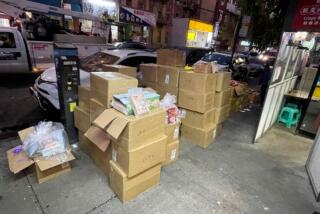Seafood in L.A. frequently mislabeled, group says
Tests on seafood sold at Los Angeles sushi bars, other restaurants, and grocery stores have revealed that more than half is not labeled correctly, a nonprofit organization is reporting.
Red snapper, Dover sole, white tuna and other fish were often different species, the group Oceana found in DNA tests of seafood from 74 retail outlets in Los Angeles. In all, 55% of 119 fish samples from across L.A. were misidentified, Oceana said.
Oceana focused on the frequency of mislabeling rather than its origins. But Beth Lowell, director of the Stop Seafood Fraud campaign at Oceana’s Washington, D.C., headquarters, said fraud can occur at any point in the supply chain, beginning when the fish is landed and through to processing, distribution and final point of sale.
TheU.S. Food and Drug Administrationprohibits so-called species substitution. Still, the practice remains prevalent. Consumer Reports found that 18% of seafood samples its researchers collected from retail stores and restaurants on the East Coast last year was mislabeled. A 2011 investigation by the Boston Globe reported that 48% of the fish it collected from Boston restaurants, grocery stores and seafood markets was sold with the wrong species name.
FDA spokesman Douglas Karas said the agency is working to determine how often, or at what point in the supply chain, fish substitution occurs. Most of the seafood fraud complaints the FDA receives come from consumers at the retail level, Karas said. The FDA is conducting a yearlong DNA test of about 800 fish collected across the nation.
In California, state Sen. Ted Lieu (D-Torrance) introduced SB 1486 in February to require large restaurant chains to label seafood accurately by species and country of origin and also indicate whether it is farmed or wild.
Lieu said the bill, which Oceana supports, addresses the health implications of seafood mislabeling. He cited a U.S. Centers for Disease Controlstatistic that imported food is one of the main causes of disease outbreaks in the United States. Eighty-six percent of all seafood consumed in the United States is imported, according to the National Oceanic and Atmospheric Administration.
In the L.A. samples, red snapper was misidentified 100% of the time, DNA tests showed. Tilapia and pollock were popular substitutes, the report said. Dover sole was discovered to be Asian “sutchi catfish” or common sole, and white tuna was often actually escolar, a snake mackerel with known diarrheal effects. The fish has been restricted in some countries.
Sushi restaurants had the highest incidence of mislabeling in Los Angeles, the study found. Oceana reported that 87% of the samples of 10 types of fish it took from 21 sushi eateries were not correctly identified.
All of the red snapper sushi sampled was mislabeled. Half of it was tilapia. Eighty-nine percent of the white tuna sampled at sushi restaurants turned out to be escolar.
Samples of yellowtail sold at sushi restaurants were often Japanese amberjack. Flounder was frequently sold as halibut, and sea bream was substituted for sea bass.
The study found that albacore, blue fin tuna, flounder and sockeye salmon were all labeled properly in sushi restaurants.
The main motivation for seafood fraud is economics. It is more profitable to sell an inexpensive fish that can pass for one that costs significantly more, especially if many consumers don’t know the difference.
Sometimes, as with red snapper and Chilean sea bass, the desired species isn’t easily available because it is overfished. Sellers mislabel those species “so people can still get what they hope they’re getting,” said Kimberly Warner, senior scientist on Oceana’s L.A. report.
Oceana did not identify the restaurants or grocery stores it sampled.
Dave Heylen, spokesman for the California Grocers Assn. in Sacramento, said stores rely on information from suppliers and take seriously their obligation to correctly identify seafood.
Oceana found that grocery stores were more accurate than restaurants. Of the 45 samples taken from 32 grocery stores, representing eight chains and one independent, nearly one-third were mislabeled, Oceana said. Of the eight types of fish sampled at grocers, only red snapper (100% of the time) and salmon (10%) were misrepresented.
Daniel Conway, spokesman for the California Restaurant Assn., said the source of mislabeling is not clear. Conway questioned Oceana’s methodology, saying the organization had used “a relatively small sample in a small geographic area.”
Oceana hopes to encourage regulations to ensure that fish can be easily traced and that anyone who mislabels it can be prosecuted.
The FDA is working with U.S. Customs and Border Protection labs to screen imported fish using a risk-based computer system that can better target imported fish violations, including misbranding. On the consumer side, the agency recommends buyers be wary of unusually low prices for fish they know generally costs more.
Lisa Simon, 66, a self-described pescatarian in Eagle Rock, eats fish two or three times a week. She said Oceana’s findings make her angry.
“It’s sort of like that pink slime stuff they put in ground beef and nobody knew about it. If halibut isn’t really halibut, God knows what it is or where it comes from,” she said. Simon said the report is likely to inspire her to eat more vegetables, beans and rice.
More to Read
Start your day right
Sign up for Essential California for news, features and recommendations from the L.A. Times and beyond in your inbox six days a week.
You may occasionally receive promotional content from the Los Angeles Times.





